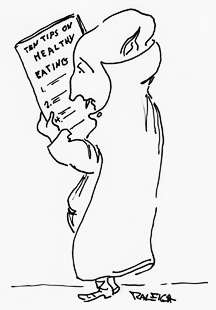Bite Me
By HENRY P. RALEIGH
ART TIMES Mar/ Apr 2010
 |
This past fall saw the release of a brace of new vampire movies along with six books on this ever-fascinating subject. One of these, How To Be a Vampire, should be of interest to do-it-yourselfers. A pretty good part of the film history has been devoted to tales of the undead, a genre that includes, in addition to vampires, mummies, zombies and, of course, all those who rise up from their graves and set about raising hell at a fairly slow and lurching pace. I figure that to qualify as a genuine member of the undead it’s really necessary to be a biter, either slurping a little blood now and then or simply gnawing on a brain, or whatever body part suits your taste. You might think that zombies are out of the running on this, however, the 1979 film, “Zombie Flesh Eaters” and the recent “Zombieland” shows they can be contenders and should be reckoned on. Actually, I’ve rarely seen a zombie in a film do anything more than stagger about, bug-eyed and aimlessly wandering so maybe we’d better hold judgment on this. Werewolves present a problem, I must admit. They are certainly biters but are they undead? When finally put to rest, is their transmission of the affliction a case of the dead being resurrected? This is not an easy matter and we need further study here. Mummies, although certainly sufficiently undead, can’t bite. I mean, how can you deliver a healthy bite with a mouth covered up in dusty strips of cloth? Mummies appear perfectly satisfied to strangle those in their way and let it go at that.
The cynosure of the undead genre is, as you might guess, the vampire. Vampire films, and boy, are there a lot of them, all take great dramatic pleasure in referring to vampires as the “undead”. It’s a prerequisite of sorts to precede the word with a pause followed by a look of utter horror. A crescendo of eerie organ music makes a nice accompaniment, too. The icon of the vampire clan is Bram Stoker’s Count Dracula. Vampire films with Dracula’s name in their titles outnumber all the others (and boy, are there a lot of them). Dracula did have a few movie predecessors that paved the way for this later entrance. Its hard to say what Cesare, played by Conrad Veidt in the 1919 “Cabinet of Dr. Caligari”, was supposed to be — a somnambulist, a fellow in a hypnotic trance, a stoner? At any rate he was kept in a box much like a vampire. “The Golem” of 1920 was a cross between a zombie and a mummy and like Cesare wasn’t a biter. The movie definition of Dracula begins with F.W Murnau’s 1922, “Nosferatur — eine Symphonie des Grauens”. Here is the very first movie biter, all right, and with an eye for young women and an aversion to sunlight. Max Schreck’s vampire set the gold standard for ugliness and it’s never been beaten. Tom Cruise in “Interview with the Vampire” of 1994 set the standard for the most pretty vampire.
Over the course of Dracula’s movie history since 1919 we can follow his family affairs as these are revealed in those films that boast his name. In 1936 he had a daughter (“Dracula’s Daughter”) who was every bit as blood thirsty as her father. In 1943 a son (“Son of Dracula”), another in 1974 (“Son of Dracula”) – this last might be the same son of 1943 but with a 31 year difference that isn’t likely and most scholars accept two sons. Now it really isn’t clear who was the mother of these children. Dracula had a choice among the swell looking vampire women he hung out with, all of them quite gifted at seductively flowing through gloomy rooms without their feet touching the floor. There is indication he may have wedded the whole lot (“Brides of Dracula”) in 1960 and in 1972 up-graded one of these to Countess (“Countess of Dracula”) and it was she who bore a trio of vampire tykes but we can’t be sure. One wonders what was going on with Dracula in 1936 and 1943 other than drinking blood. It’s best to keep in mind that vampires are, after all, the undead and probably don’t give a hoot for our notions of linear time. We also find that the Count enjoyed a comfortable home life and in 1978 kept a dog (“Dracula’s Dog”) who was a vampire as well. He liked to travel and we know he visited the American West in 1966 (“Billy the Kid vs. Dracula”) and possibly Brooklyn, though that’s not confirmed. When he eventually packed it in – just how many stakes in your heart can a vampire take, I ask you? —Christopher Coppola, nephew of Francis, honored his name in his 1989 “Dracula’s Widow”, the Countess heading for Los Angeles to live in a wax museum.
Bela Lugosi’s Dracula, in Tod Browning’s film of 1931, is still the image of the Count we usually have in mind despite some bizarre variations that appeared later – Klaus Krinski’s Dracula was rat-like, Gary Oldman’s foppish. But Lugosi was ever elegantly sinister, certainly as a vampire should be. Anne Rice, the author of the popular Vampire Chronicles, has said she had been inspired when as a girl she saw “Dracula’s Daughter” in 1936. I don’t know about being inspired or not after seeing Brownings’s “Dracula” at about the same time – it did scare the socks off me and made such a lasting impression that I never utter the word “undead” without the appropriate pause and shudder. I like the line ‘children of the night’, too but find few occasions to actually use it.
Send your comments to info@arttimesjournal.com
